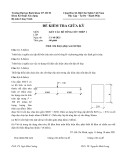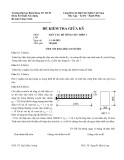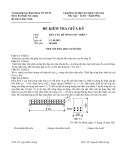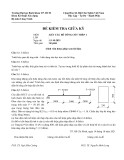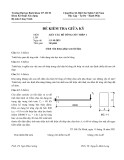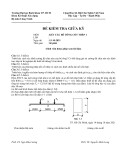
ISSN 1859-1531 - THE UNIVERSITY OF DANANG - JOURNAL OF SCIENCE AND TECHNOLOGY, VOL. 22, NO. 11B, 2024 117
SENSITIVITY ANALYSIS OF FACTORS INFLUENCING THE RELIABILITY OF
REINFORCED CONCRETE COLUMNS STRENGTHENED WITH
FABRIC-REINFORCED CEMENTITIOUS MATRIX
Dang Cong-Thuat1*, Le Khanh Toan1, Pham My1, Dinh Ngoc Hieu1,2
1The University of Danang - University of Science and Technology, Vietnam
2School of Architecture, Soongsil University, South Korea
*Corresponding author: dangcongthuat@dut.udn.vn
(Received: September 15, 2024; Revised: September 25, 2024; Accepted: October 15, 2024)
DOI: 10.31130/ud-jst.2024.532E
Abstract - This paper presents a sensitivity analysis of key factors
influencing the reliability of reinforced concrete columns
strengthened with Fabric-Reinforced Cementitious Matrix
(FRCM) with carbon fabric. Key parameters examined include
axial force, concrete compressive strength, longitudinal
reinforcement diameter, and stirrup diameter. Results indicate
that axial force exerts the most significant impact on column
reliability, with a notable increase in failure probability as axial
force rises. Enhancements in concrete compressive strength and
longitudinal reinforcement diameter improve reliability by
reducing failure probability. Stirrup diameter and spacing are also
critical for structural safety and collapse prevention. Furthermore,
the analysis reveals that while higher axial force enhances the
column's lateral load-bearing capacity, it concurrently reduces the
structural ductility.
Key words – Retrofit; reinforced concrete columns; carbon
fabric; sensitivity analysis; reliability.
1. Introduction
Structural buildings (such as industrial buildings, bridges,
and seaports) are subject to random dynamic loads under
normal usage conditions. Additionally, there are random
factors in the materials, dimensions, and applied loads of these
structures that must also be accounted for [1]. This results in
the structural response behaving stochastically, occasionally
exceeding pre-determined allowable limits (damage
thresholds), such as displacements or stresses that surpass
permissible values. The probability of such excessive
responses is termed as the structure’s failure probability or its
reliability probability. Thus, determining the failure
probability in the presence of random input fluctuations
becomes a structural reliability analysis problem [2].
It is widely recognized that model outputs in structural
analysis are highly influenced by random input variables.
These variables are often estimated from limited statistical
data or experience, leading to inaccuracies. This raises the
issue of evaluating how input variables affect model
outputs to optimally adjust parameter values and enhance
model accuracy. The concept of sensitivity [3], rooted in
using derivatives to examine the impact of changes in
related quantities, is pertinent here.
In structural mechanics, sensitivity analysis is an
innovative yet highly effective method to address structural
reliability challenges, as outlined above. This approach,
known as structural sensitivity analysis, examines how
structural response states (such as displacements, internal
forces, stresses, natural frequencies, and modal shapes)
depend on changes in the physical and geometric
parameters (such as stiffness, density, cross-sectional area,
elastic modulus, viscosity coefficient, and plate thickness)
under static or dynamic loads [4].
Therefore, this study proposes a sensitivity analysis of
key factors influencing structural reliability, including
structural geometry, applied loads, and material corrosion.
Sensitivity analysis results will reveal the most critical
parameters and yield a reliability profile, indicating the
relationship between the probability of structural failure
and various input parameters. This has significant practical
benefits, such as identifying necessary structural
performance levels corresponding to design load ratings,
estimating operational risks, and establishing a rational
basis for maintenance decisions.
In structural buildings, reinforced concrete (RC)
columns are critical structural components and may suffer
from various damages, such as brittle shear failure and
concrete crushing, rebar buckling, and connection issues at
splice joints. To enhance the resilience of these RC
columns, numerous reinforcement methods and details
have been developed, including steel and concrete jackets.
This study investigates the use of carbon Fabric-
Reinforced Cementitious Matrix (FRCM) as the
strengthened jacket for RC columns subjected to seismic
loads. The study and application of new materials like
FRCM for strengthening RC structures under seismic loads
is also an area of global research focus. These studies
primarily explore the use of innovative materials and
technologies to improve earthquake resilience of existing
structures, particularly in high-seismic-risk areas.
2. Retrofitting of RC columns using FRCM materials
To apply FRCM composite materials practically in
civil and structural engineering for retrofitting RC concrete
columns under seismic loads, a strengthening method is
proposed with lap joints. Figure. 1 illustrates the schematic
of the seismic strengthening of RC columns using FRCM
composite materials. The specimen is reinforced with four
L-shaped FRCM segments attached to the corners of the
RC column, joined together with fiber mesh with a lap joint
length of 200 mm. Surface coating techniques for
overlapping carbon mesh are applied to improve the
bonding between the meshes and the matrix.









